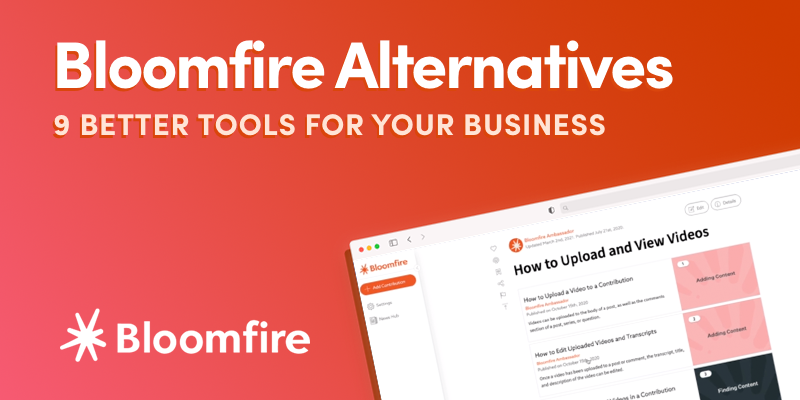Bloomfire Alternatives: 9 Better Tools For Your Business
Last Updated on March 28, 2024 by Owen McGab Enaohwo

Have you tried out Bloomfire and were unsatisfied with its features?
Do you want a better alternative to Bloomfire? You have come to the right place.
Every business needs a tool that properly documents and manages its processes and policies while ensuring that it is readily accessible. Such tools not only help to document processes but also simplify your day-to-day operations, provide you with a knowledge base of relevant information, improve employee onboarding and training, and ultimately increase productivity within your organization.
As good as Bloomfire might be, it does not provide a full suite where you can access the features easily. It has a lot of pitfalls that might make it a bad fit for your company. There have been several complaints by users about gaps in its efficiency.
Why the Need for a Bloomfire Alternative?
Even though Bloomfire is a well-known tool for knowledge management, it has its own set of limitations.
For one, it does not offer extensive integration as some other tools do. It is integrated with a few third-party tools, a far cry from tools with over 1,000 integrations.
It also doesn’t provide SEO functions. The fact that you created a public knowledge base on the software does not guarantee that it will appear on search engines.
Even if these can be overlooked, the pricing does not help. It is quite expensive compared to other tools with similar functions. It costs $25 for each user per month. Even if you have a small team of 10, that’s $250 monthly.
Check out some of the reviews from users of Bloomfire:
Some users complained about the difficulty in finding links and videos. According to a user, the number of materials their organization shares is huge, and it becomes hard to find what they need.
Another user stated that the app is not easy to use and requires instructions and directions. There have also been complaints that lessons organized on the platform do not go as planned.
With these complaints, getting a better alternative is a step in the right direction.
Looking for the best Bloomfire alternative you will ever find? Try our SweetProcess today and explore its numerous features for free with no card required.
Table of Contents
Chapter 1: Top 9 Bloomfire Alternatives
Chapter 2: Factors to Consider Before Choosing a Bloomfire Alternative
Chapter 3: SweetProcess: The Best Bloomfire Alternative for Your Business
Chapter 1: Top 9 Bloomfire Alternatives

If Bloomfire doesn’t fit your company’s needs and goals, which alternative should you opt for?
We understand that the process of choosing this can be quite tasking. There are over 100 alternatives on the internet, and every alternative claims to be the best. Instead of spending hours combing through these alternatives and getting confused at the end of the research, we have done the hard work for you.
Based on our research, these are the nine best alternatives you should choose instead of Bloomfire. Let’s check them out.
1. SweetProcess


SweetProcess is an all-in-one business process management tool that allows users to document and manage their processes, policies, procedures, tasks, and other relevant company information in one place.
Imagine everything that Bloomfire does; SweetProcess does it better and provides more features to explore. It can be used to document standard operating procedures, visualize and master workflows and processes, implement company policies, manage tasks and, just like Bloomfire, create a knowledge base for your company.
This Bloomfire alternative is an excellent tool for employee onboarding and training. It makes the entire process easier and faster, reducing employee errors that might cost your company time and money.
It has a simple yet comprehensive dashboard that makes it easier to access its features without so much navigation and makes it one of the most user-friendly tools you will ever come across. It provides templates you can easily customize to suit your business needs and identity.
SweetProcess is adept at tracking productivity within your company. All these features come together to make the creation and execution of tasks easy. You know who is doing what and within what timeline it is to be completed. The cloud-based knowledge base stores all your important information in one place. You can make it private or public, depending on your preference.
The best part is that it has a free 14-day trial option, no card required, that allows you to explore the software and decide if it is a good fit for your business before you commit to it financially. Click here to enjoy the full benefits of SweetProcess today for free.
Features:
- Document step-by-step procedures and policies.
- Combine multiple procedures together to make an overarching workflow.
- Create a private or public knowledge base.
- Turn your procedures into actionable tasks for your staff.
- Connect with over 1,000 integrated apps.
- Collaborate in real-time with members of your team.
- Create process maps to visually explore every step in your process.
- Enjoy account security with two-factor authentication.
- Turn your policies and procedures into an offline manual that can be exported.
- Import videos, images, and files into your documents.
- Access support via email and phone calls.
How Do SweetProcess Features Work?

This is what the dashboard looks like when you start creating processes and policies.
How to Document Your Procedure on SweetProcess
Step 1: Click on “Create Procedure.”

Step 2: Put in your procedure title.

Step 3: Create your procedure step-by-step. While creating, you can easily insert multimedia files like images, videos, and links (including links to other policies and procedures).

Note: SweetProcess allows you to request approval, approve the procedure and notify other team members, or approve and request sign-off.
Step 4: Approve your procedure, and it goes live.

Congratulations, your procedure is now live.

How to Create a Knowledge Base
Step 1: Click on “More” and choose “Knowledge Bases” from the drop-down menu.

Step 2: Click on “Create Knowledge Base.”

Step 3: Put in the title of your knowledge base.

Step 4: Create a category.

Step 5: Click on “Add New Article” to upload your preferred policy, document, or procedure into the knowledge base.

Note: You can control who has access to the knowledge base—the general public or just your team members.

Your knowledge base is now live!
These are just a few of its features. You can see how easy it is to navigate the interface. You can document your processes and policies in just a few clicks.
The exciting part is that these few clicks yield results. Tom Vranas, vice president of innovation and culture at Everywhere Wireless, was able to scale the company by enhancing its employee onboarding process and training with SweetProcess.
After choosing SweetProcess, the company enjoyed an improved customer experience, effective documentation of business processes, and the creation of a decentralized knowledge base.
Pricing
SweetProcess provides one plan for all its users. It costs $99 per month for a team with up to 20 active members. It costs an additional $5 per month for each additional active member. You get 16% off if you opt to be billed annually.
You can also contact the team if you have fewer than 20 employees for the special pricing for smaller teams.
Unlike many tools, it offers a 30-day money-back guarantee. If you don’t see a measurable improvement in your business, your money will be refunded, no questions asked. In addition, you get a free one-hour phone consultation to brainstorm result-driven strategies to grow your business.
Pros
- Since it has one pricing plan, all users can access the entire suite of features.
- It offers a 30-day money-back guarantee, no questions asked.
- SweetProcess only bills you for the number of people who use it, and if a person using SweetProcess becomes inactive, you will receive a prorated credit to your account.
- Some users stated that SweetProcess sends timely reminders to whoever is holding up the project. This removes the need to constantly send reminders to team members.
- It requires almost no learning curve. You can immediately start creating your policies, procedures, knowledge base, etc., without needing a tutorial video.
- It is great for training new employees and hosting training materials in one place.
- It offers the option to make your knowledge base public or private.
- It is quite affordable and provides special pricing plans for companies with small teams.
Start using SweetProcess for free today. Take advantage of the 14-day free trial offer; no credit card is required.
2. Guru

Guru is a cloud-based knowledge management software that centralizes a company’s knowledge on a single, searchable platform. It serves as a company’s wiki that documents a company’s processes and workflow and helps provide you with the information you need at your fingertips.
It helps your team to create, access, share, and update information right in the context of your company’s existing workflow, thereby assisting your marketing, sales, and support teams in constantly providing a quality customer experience.
Pricing
Guru has a Starter package that is free for a team of three. If you need more users, you start with $5 per user per month. It also has the Builder package, which charges $10 per user monthly. The Enterprise package requires you to contact sales for pricing.
Features
- Collaboration tools
- Content management
- Customizable templates
- Data import/export
- Document management
- Knowledge management
- Progress tracking
- Search/filter
- Secure data storage
- Self-service portal
- Third-party integrations
Pros
- Your team members can add comments and ask questions, thanks to the collaboration feature.
- Its knowledge alerts feature allows you to keep your team up-to-date on relevant information like product announcements, new updates, etc.
- You can easily update the knowledge base with new frequently added questions. This allows users to find answers quickly.
Cons
- It has very limited options for the Starter package. Most of the features in the Builder and Enterprise packages are not included in the Starter package.
- Some users complained about the inability to view their user’s perspective of the knowledge base, which makes it harder to troubleshoot and validate the right setting.
- A customer mentioned that the tagging and searching system on Guru has gaps. The analytics on the platform could be more streamlined.
- Another review from a user stated that it is better simply as a knowledge base and not great for documenting workflows, diagrams, and such.
3. Trainual

Trainual is a knowledge transfer platform that allows businesses to create and manage their training programs for employees. It provides one simple tool that helps companies centralize policies and procedures, automate onboarding and training of employees, and build a foundation to scale their businesses faster.
It is designed for businesses that are growing quickly and eager to document systems and processes, define workflows, and ensure proper and consistent training of employees.
It also allows businesses to create training programs tailored to their specific needs and industry and assign training materials to specific employees. This makes it easy for managers to track employee progress and ensure that everyone is on the same page.
Features
- Progress tracking and certifications
- Course authoring
- Learning administration
- Document management
- Compliance management
- Reporting and analytics
Pricing
It has no free version. However, it provided a seven-day free trial period. The Train plan costs $99 per month. This plan includes 10 seats and costs $3 monthly to add more seats.
The Scale plan is $199 per month. Twenty seats are included in this plan. It costs $4 monthly to add additional seats.
Pros
- It is available on the web and as a mobile app.
- Creating and managing processes in the software is quite easy.
- It allows businesses to update their information on the training programs quickly as new updates pop up.
- Employees can track their progress easily.
Cons
- It requires a learning curve to fully understand how the software works.
- The organization chart on Trainual can be clumsy and difficult to view.
- Although you can assign roles to a subject, you can’t assign roles to a topic, which makes it quite hard to assign training content with precision.
- A user noted that the search engine could be better as it is sometimes not so good at finding the right content.
4. Notion

Notion is a project management tool that allows small to large businesses streamline and manage their tasks, notes, records, projects, and so on. It is a wonderful tool for keeping all your project-related information in one place while building and sharing workflows.
It presents you with a product roadmap, repository patterns, and task lists. It also streamlines project workflows from start to finish. In addition to its project management functions, it fosters collaboration between team members while they carry out tasks.
Features
- Accessed on the web, desktops, and mobile apps
- Wikis, docs, and notes
- Over 40 block content types
- Multiple starter templates
- List, calendar, tables, gallery, kanban board, and timeline views
- Multiple databases with rich property types
Pricing
It has a free plan that gives unlimited blocks to individuals and limited blocks to businesses. The Plus plan bills $8 per user every month (billed annually) and $10 when billed monthly.
The Business plan costs $15 per user monthly (billed annually) and $18 per user when billed monthly. For the Enterprise plan, you have to contact sales to request pricing.
Pros
- It works across different devices. It has a web app, a desktop app for both Mac and Windows, and mobile apps for iOS and Android.
- It allows you to take notes easily and organize your pages.
- It notifies you about the delay in activities without being invasive.
- It serves as a flexible digital workspace with all your documents and workflows in one place.
Cons
- It can be quite challenging for new users to navigate Notion. You have to spend time getting familiar with its interface.
- Some users noted that the formatting and editing text functions were not intuitive enough.
- It does not allow personalization or the use of corporate colors when creating notes for businesses.
- It could increase its integration with other third-party tools for a more robust experience.
5. eXo Platform

eXo Platform is an open-source collaboration platform with a robust knowledge management feature. This solution enables businesses to centralize their knowledge to increase performance and improve employee training.
It allows you to document, store, and share knowledge quickly, including policies, processes, and any other important information. With this tool, you can make edits remotely, access the version control feature, and secure backups.
More than just documenting, it makes it easy for businesses to create and maintain enterprise wikis and streamline knowledge sharing among every member of the team. Thanks to its permissions management feature, users can have access to the information they need while ensuring that sensitive information remains private.
Features
- Task management
- Mobile access
- Communication features
- Notifications
- Comments and feedback
- Sharing and privacy
- Internal knowledge base
- Image, audio, and video files
- Document collaboration
- Integrations
Pricing
The Community plan (which is ideal for universities and organizations with technically savvy teams) is free.
The Enterprise plan (which is ideal for medium-sized companies or administrations transitioning to the sovereign cloud) costs $5 per user, per month.
The Ultimate plan, which is ideal for organizations looking to build their digital workspace, is quote-based. You have to request a quote from the company.
Pros
- It is quite affordable, which makes budget-conscious users appreciate it even more.
- It is easy to navigate. Non-tech-savvy users can learn how to use the tool quickly.
- It is an all-in-one collaboration, communication, and knowledge management solution.
- It allows you to connect to your company’s account through social media accounts like Google, Facebook, and LinkedIn.
- It has a chat application with HD videoconferencing capabilities, which is an added bonus for users.
Cons
- Some users complained about the absence of manuals and documentation. This makes configuration and setup difficult for some businesses.
- Others complained about excessive loading times and an overall sense of clunkiness while using the software.
- Even though it allows connection with social media accounts, the process is not so easy.
- A user mentioned that customizing some features can take a lot of time.
6. Confluence

Confluence is an enterprise collaboration tool that was developed by Atlassian. It allows teams to document information and processes and enables them to organize this information in a centralized location. This gives room for accessing information quickly and easily.
Apart from properly documenting information, it provides collaboration tools for its users, including comments, mentions, and discussion threads, as well as integration with other Atlassian tools like Trello and Jira.
It provides you with a virtual shared workspace that helps you create and manage all your work in one place. It allows users without Confluence accounts to view shared documents. However, they will not be able to make any edits to the documents.
Features
- Collaboration tools
- Commenting/notes
- Content management
- Document management
- Email management
- Gantt/timeline view
- Knowledge base management
- Progress tracking
- Reporting/analytics
- Third-party integrations
- Version control
Pricing
Confluence is free for up to 10 users, and it is billed monthly. The standard package is priced at $5.75 per user. The pricing goes up to $11 per user in the Premium package. The Enterprise package, which is billed annually, requires that you contact sales for pricing.
Pros
- It enables integration with third-party tools like Jira and Trello.
- It is available on both desktop and mobile apps (both Android and iOS).
- It provides good analytics, which let you track your project’s progress and engagement on your documents.
- It is a good collaboration tool.
- It can also be accessed via the Confluence mobile app.
Cons
- It does not have SEO functions.
- It might require some learning before you can properly navigate the tool. This shaves off valuable time that could have been spent working on your project.
- Users who subscribe to the free or lower-priced plan miss out on important features of the tool.
- Navigating Confluence’s search feature can be quite challenging for new users.
7. Sabio

Sabio is a cloud-based, cross-organizational knowledge management tool for businesses of all sizes. With this solution, members of the team can quickly document and store the company’s information.
It makes use of the “tree” structure. This allows the users to search for their knowledge base articles seamlessly. It provides users with great archiving features, version control features, and customizable templates.
Thanks to its knowledge base analytics, you can quickly optimize your knowledge base to make it more efficient. You can also access it through your iOS and Android mobile devices. Apart from its knowledge base management features, it also offers plugins for Salesforce, Zendesk, and so on.
Features
- Ease of use
- CRM support
- Effective API
- Ticketing app integration
- Supports plugins for ZenDesk, FreshDesk, and Salesforce
- Available on iOS and Android
Pros
- Implementation and navigation within the software are quick and easy.
- It is suitable for all types and sizes of businesses.
- It has an efficient and intuitive editor that allows users to make quick changes to the content and make improvements to the structure of their knowledge base.
- It makes use of simple tree structures which further aid the simplicity of the platform.
Cons
- Even though it has a search feature, some users explained that the software could use more smart technology to keep insights and knowledge bases up to date.
- Some users requested more customizable features so that their knowledge base could have the company’s “look and feel.”
- A user experienced a delay in making editorial changes to the knowledge base. This can sometimes take some time when trying to make several edits.
- The software could use more integration with other tools.
8. Document360

Document360 is a SaaS platform that helps you create online self-service portals that you, your employees, and your customers can access. It allows you to build and manage multiple knowledge bases across different domains.
It is also great for creating documents and organizing those documents into categories within the knowledge base. With the tool, you can create standard operating procedures, FAQ pages, enterprise knowledge management, and internal wiki pages.
Beyond creating knowledge bases and documenting information, it serves as a collaboration tool. Team members can view and make changes to the documents in the knowledge base. You, however, can apply restrictions to who can access what.
Features
- Integrations and extensions
- Access control and permission
- Custom domain and CSS
- Version control and rollback
- Bulk operations
- Collaboration
- Document management
- Multiple language support
- SEO optimization
- Workflow management
Pricing
Document360 has a free plan. The Startup plan costs $99 per project, per month. The Business plan costs $249 per project, per month. Finally, there is the Enterprise plan, which costs $499 per project, monthly.
Note that Document360 accepts payment in USD, GBP, EUR, and AUD.
Pros
- It gives room for easy customization to suit your company’s needs. It allows you to customize your knowledge base according to your company’s branding.
- It provides permission-based access. You can control who sees what.
- It generates analytics on the performance of your knowledge according to metrics.
- It is quite easy to implement and simple to use.
Cons
- It is strictly a web-based software. It is not accessible via mobile apps.
- Some users requested more video tutorials for functions in the software.
- A user complained that the process of importing articles from Word is not entirely seamless.
9. ProProfs Knowledge Base

ProProfs Knowledge Base is a cloud-based knowledge management tool that helps businesses create private and public knowledge bases, documentation, manuals, help centers, FAQs, and much more.
It is suitable for all types of businesses. Its library of templates helps you dive straight into the content creation process without stressing over design or structure. It also has features like single sign-on and password controls that ensure the security of your knowledge base is never compromised.
The built-in reports within the software are generated weekly, monthly, or even yearly. Other notable features provided by the software include revision history, workflow approvals, and so on.
Features
- Self-service portal
- Access controls/permissions
- Knowledge management
- Content management
- Discussions and forums
- Knowledge base management
- Decision support
- File management
- Commenting/notes
Pricing:
ProProfs Knowledge Base has an Essentials plan that costs $30 per author, per month. The Premium plan costs $40 per author, per month while the Enterprise plan requires you to reach out to them for a quotation.
Pros
- It can be accessed from any device. It is available on the web and in its mobile app.
- A user complimented the search function and how it provided Google-like results. This makes it easy to find information.
- It gives you control over permissions, so you get to decide who you restrict or give access to a page.
- It provides in-depth reports that include numbers like how many articles you create, ratings of each article, and so on.
Cons
- It is quite expensive compared to similar apps, which makes it inaccessible to businesses on a strict budget.
- A user complained about how tedious it is to manage the landing pages, especially since it is usually hard to find access.
- Another user suggested that the tool could use more customization options to help create a sense of brand identity.
- Some features have hidden access and are not visible, which sometimes makes it easy to forget where things are.
There you have it, the top nine Bloomfire alternatives.
You don’t have to keep using Bloomfire when it doesn’t meet your needs. It’s time to take a pick. Which will you be going for?
But before you make a decision, let’s consider the factors to consider before choosing an alternative. With this list, you can compare the features of each alternative and see if they meet the requirements.
This makes it even easier for you to make an informed decision. We will be reviewing these factors in the next chapter.
Chapter 2: Factors to Consider Before Choosing a Bloomfire Alternative

You can’t just choose an alternative because it sounds great. There are things to look out for to ensure that this time around, the tool you choose will fulfill your company’s needs and give you value for the amount you are paying.
Here’s our list:
- Your business needs: This is very important. Whatever tool you choose should be able to fulfill your business needs. For example, if you are a large organization, you might want a tool that can cater to a larger team.
- Interface and design: Is it simple to use? Can you easily navigate the interface? Do you have to spend hours watching tutorial videos before you can use the tool? If the answer to these questions is yes, then you can go ahead and choose it.
- Collaboration: Your ideal alternative should make collaboration very easy for you and your team. It should allow you to create, share, and make changes to your documents or knowledge base in real-time.
- Customization: You should be able to make your desired tool fit into your company’s identity and needs. It should contain ready-to-use, customizable templates. It should also allow you to create custom URLs for your knowledge base and, if possible, allow you to include brand colors, etc. to enhance your brand identity and make it feel like it is yours.
- Effortless authoring: The process of creating documents, policies, and processes should be extremely seamless. Features like the import of documents, editing content, including multimedia files, sharing files, etc., are a must for your alternative. You shouldn’t have to struggle with the basics.
- Reminders and progress tracking: Does your preferred alternative send you reminders when projects need to be completed? Does it make it easy to track the progress of every team member so you know you are responsible for actions within each stage of the workflow? If it doesn’t, then you might have to reconsider your choice.
- Integration with other tools: Integration with third-party tools makes the process a lot easier. It also helps to make the most of your tools. You want to look at what tools they are integrated with and how those tools make the process of documentation and management easier.
- Reporting and analytics: A robust reporting and analytics function is something you don’t want to miss out on.
- Pricing: Is the amount it will cost you worth the benefits you will derive from using this alternative? If the answer is no, then keep walking. You do not want to have an overpriced tool that does not deliver on its promise.
Now you have the factors. At this point, you have everything you need to go shopping for a worthy Bloomfire alternative.
Chapter 3: SweetProcess: The Best Bloomfire Alternative for Your Business

If you truly want the best Bloomfire alternative, then the tool you should be looking for is SweetProcess.
It checks all the boxes we listed earlier, and it does way more than just create a knowledge base, which is the main function of Bloomfire.
SweetProcess makes it super easy to manage your tasks, create workflows, and track your productivity. It takes your entire work process, helps you simplify it, and even tracks your progress as tasks are completed. Imagine an online assistant for your business, but this time, it is software.
Take Stone & Wood, for example. They are a brewing company with over 150 employees, but it still had to battle with the issue of working with binders and Microsoft for documentation. This made following administrative processes difficult, and updating work procedures became a hassle.
But with SweetProcess, their business performance improved because they were able to structure their operations. SweetProcess helped them to simplify employee onboarding and training, create a centralized knowledge base to make information readily accessible, and enhance the process of updating procedures and processes.
SweetProcess doesn’t just work for small businesses. School communities like the Belvidere Community School District make good use of SweetProcess’s effective business process documentation to train more efficient staff.
Managing all the schools without proper documentation of the necessary work procedures to follow was extremely hard. Google Docs and Word didn’t cut it. In fact, the majority of the team members had no idea these documents existed. However, once they switched to SweetProcess, they were able to create a centralized knowledge base that served both teachers and parents. They had access to comprehensive documentation with the proper search functions so the documents could easily be found. Finally, SweetProcess helped streamline employee onboarding.
They achieved all of this with just one tool.
Whether you are a small, medium, or large organization, SweetProcess helps you streamline your operations for success. This is your chance to become one of the companies that enjoy the full benefits of SweetProcess.
Check it out yourself. You get access to the full benefits of SweetProcess with the 14-day free trial. Try it out and see for yourself.
Conclusion
It’s been a long read, but we are sure you now have the answer you need. You don’t have to stick with Bloomfire if you are not satisfied with its output.
You have everything you need to make the right decision. Your business deserves a solution that can not only document your processes but also manage them effectively.
If you want the best tool for documenting your processes and creating a knowledge base for your business, sign up for a free trial of SweetProcess today. No credit card required.










Leave a Reply